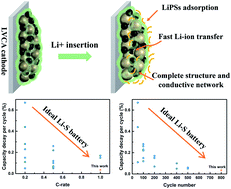A well-designed polymer as a three-in-one multifunctional binder for high-performance lithium–sulfur batteries†
Abstract
The commercial application of lithium–sulfur batteries is mainly restricted by their quick capacity decay and poor cycle life due to the shuttle effect, insulating nature of sulfur, and cathode structure pulverization. Herein, a new type of lithiated polymer binder based on a vinyl chloride-acrylic copolymer (VCA) is constructed for the sulfur cathode. Experimental results and theoretical calculations both reveal that the lithiated vinyl chloride-acrylic copolymer (LVCA) binder possesses strong interactions with lithium polysulfides, enabling inhibition of the shuttle effect. The high adhesion strength of the LVCA binder effectively maintains electrode integrity and ensures good electronic conductivity during long-term cycling. Besides, the appropriate electrolyte uptake and abundant –COOLi groups of the LVCA binder endow the sulfur cathode with fast lithium-ion diffusion. Consequently, the sulfur cathode with the LVCA binder exhibits a 2.0-fold increase in the discharge capacity and a low capacity decay of only 0.04% per cycle after 800 cycles at 1C, compared to that with a PVDF binder. The rate performance of the sulfur cathode with the LVCA binder is also greatly enhanced, retaining a high discharge capacity of 704.9 mA h g−1 at 2C. This study provides an effective strategy for improving the electrochemistry performance of lithium–sulfur batteries by simple application of a new and low-cost copolymer binder.



 Please wait while we load your content...
Please wait while we load your content...